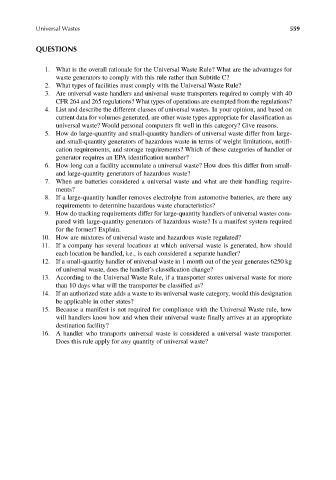Page 588 - Materials Chemistry, Second Edition
P. 588
CAT3525_C18.qxd 1/27/2005 12:47 PM Page 559
Universal Wastes 559
QUESTIONS
1. What is the overall rationale for the Universal Waste Rule? What are the advantages for
waste generators to comply with this rule rather than Subtitle C?
2. What types of facilities must comply with the Universal Waste Rule?
3. Are universal waste handlers and universal waste transporters required to comply with 40
CFR 264 and 265 regulations? What types of operations are exempted from the regulations?
4. List and describe the different classes of universal wastes. In your opinion, and based on
current data for volumes generated, are other waste types appropriate for classification as
universal waste? Would personal computers fit well in this category? Give reasons.
5. How do large-quantity and small-quantity handlers of universal waste differ from large-
and small-quantity generators of hazardous waste in terms of weight limitations, notifi-
cation requirements, and storage requirements? Which of these categories of handler or
generator requires an EPA identification number?
6. How long can a facility accumulate a universal waste? How does this differ from small-
and large-quantity generators of hazardous waste?
7. When are batteries considered a universal waste and what are their handling require-
ments?
8. If a large-quantity handler removes electrolyte from automotive batteries, are there any
requirements to determine hazardous waste characteristics?
9. How do tracking requirements differ for large-quantity handlers of universal wastes com-
pared with large-quantity generators of hazardous waste? Is a manifest system required
for the former? Explain.
10. How are mixtures of universal waste and hazardous waste regulated?
11. If a company has several locations at which universal waste is generated, how should
each location be handled, i.e., is each considered a separate handler?
12. If a small-quantity handler of universal waste in 1 month out of the year generates 6250 kg
of universal waste, does the handler’s classification change?
13. According to the Universal Waste Rule, if a transporter stores universal waste for more
than 10 days what will the transporter be classified as?
14. If an authorized state adds a waste to its universal waste category, would this designation
be applicable in other states?
15. Because a manifest is not required for compliance with the Universal Waste rule, how
will handlers know how and when their universal waste finally arrives at an appropriate
destination facility?
16. A handler who transports universal waste is considered a universal waste transporter.
Does this rule apply for any quantity of universal waste?

